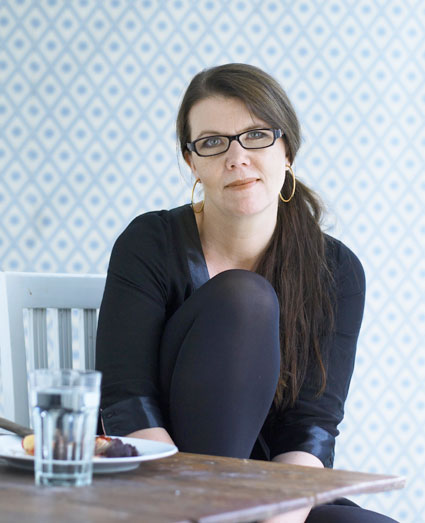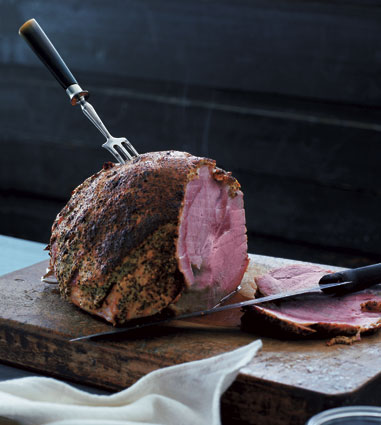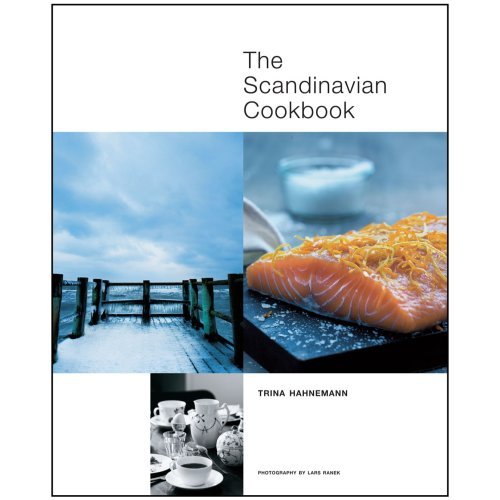 ‘A good cookery book should always be covered in food stains,’ laughs Trina Hahnemann when I tell her about the sorry state of my copy of her excellent The Scandinavian Cookbook. It’s a book so packed with recipes that leap off the page and demand to be cooked that I’ve had a hard time keeping my sticky hands off of it. In fact, it’s finest moment came when it provided the roast pork recipe for our Christmas lunch.
‘A good cookery book should always be covered in food stains,’ laughs Trina Hahnemann when I tell her about the sorry state of my copy of her excellent The Scandinavian Cookbook. It’s a book so packed with recipes that leap off the page and demand to be cooked that I’ve had a hard time keeping my sticky hands off of it. In fact, it’s finest moment came when it provided the roast pork recipe for our Christmas lunch.
Scandinavian cooking is certainly popular with the food writers who are wearing a groove in the ice as they travel back and forth to the frozen north, so what’s the big attraction? Trina ponders a second, ‘Well its new, people are always looking for something they haven’t tried before,’ she says ‘and the other thing is that its perceived as very healthy and easy to cook with nice seasonal ingredients. I also think the taste in the basic things that make up the Scandinavian kitchen has something to with traditional English cooking too, we have something in common in both the seasoning and the seasonality.’
Hers is literally a book built around the seasons with fabulous photography that makes you yearn to see for yourself the weather change as the temperature fluctuates. Right now in January Trina’s book is cooking wonderful rye bread, which then becomes an open sandwich laden with plaice, prawns and basil dressing. Root vegetables, their flavour intensified by frost and then roasted slowly, surround a chicken.
 Of course the cliché is herrings, but this book shows there is so much more to savour and that savour is greater through waiting for things to appear naturally. ‘From May to June we have so many fresh herbs -between those dates, depending on the weather, we have thyme and lovage and dill, chives, rosemary,’ Trina enthuses. In March her book tempts you with, yes, herring. The fillets are dunked in rye flour and folded over a filling of mustard and dill before being pan-fried in butter. The cooled result is then marinated for two hours before coming gloriously to the table. A family feast of spring leg of lamb as pink as can be is stuffed with mint, apricot and celery and served with spinach and roast potatoes.
Of course the cliché is herrings, but this book shows there is so much more to savour and that savour is greater through waiting for things to appear naturally. ‘From May to June we have so many fresh herbs -between those dates, depending on the weather, we have thyme and lovage and dill, chives, rosemary,’ Trina enthuses. In March her book tempts you with, yes, herring. The fillets are dunked in rye flour and folded over a filling of mustard and dill before being pan-fried in butter. The cooled result is then marinated for two hours before coming gloriously to the table. A family feast of spring leg of lamb as pink as can be is stuffed with mint, apricot and celery and served with spinach and roast potatoes.
Throughout the book rye flour and caraway seeds occur again and again and Trina is unrepentant. ‘Caraway seeds?’ she laughs? ‘They are part of our world, like rye bread. I love them sprinkled in salads and we use them inside cheese and on top of soft smoked cheeses. We use them for herrings and in bread and in all kinds of stews!’ She recommends her recipe of Smoked salmon and horseradish cream with crunchy cucumber and caraway seed salad, one of her treats for April, as a way of enjoying the unique caraway flavour.
Her book features a fair bit of delicious baking, so I ask if it’s down to the cold weather but Trina has another explanation. ‘Well that’s part of it,’ she admits, ‘but I also think that it’s traditional to have nice bread. We haven’t lost the art of home baking, fresh yeast is available everywhere all the time, my local all night store around the corner sells it, even at the weekends because people still remember the days when you couldn’t buy bread on a Sunday so you would bake. If you have children, and a special celebration, you always bake the buns and cakes yourself; it would be rare to order it. We haven’t lost the art and its hard to know why because you know women have been working outside the home for forty years now in Scandinavia and we are finding the time to bake still!’
 Her book features, of course, Danish Pastries, a feature of Danish birthday breakfasts, and her recipe is for deliciously decadent pastries iced with chocolate. A far cry from the ‘Danish’ my local café sells.
Her book features, of course, Danish Pastries, a feature of Danish birthday breakfasts, and her recipe is for deliciously decadent pastries iced with chocolate. A far cry from the ‘Danish’ my local café sells.
That Trina is an ambassador for Scandinavian cooking is ironic as she first came to England with her husband who worked at the Danish embassy. Today as well as her recipe writing she enthuses about the restaurant scene in Scandinavia.
‘Noma has played such a big part in creating that buzz,’ she says referring to the restaurant on the ground floor of an old warehouse at the edge of the quay in Copenhagen. The room preserves tradition but spins a modern twist and so does the cooking. ‘It is such an unusual restaurant with an unusual menu,’ Trina explains. ‘It’s so true to the Scandinavian kitchen but on a higher level. What chef Rene Redzepiis doing is excellent and interesting and he is always looking at new ways of doing things. And yet he is in many ways basic, he uses lots of vegetables and is very seasonal. His influence is encouraging young talented Scandinavian chefs to stay and work in Scandinavian cuisine and not to jet off to Paris, New York, London.’
 Trina’s book is enough to convince any foode of the value of Scandinavian cooking, bringing a blast of fresh air to the kitchen and encouraging us all to revitalise our meals. It celebrates the joys of a life where each season is happily looked forward to and which constantly produces a different bounty of flavours and textures to savour.
Trina’s book is enough to convince any foode of the value of Scandinavian cooking, bringing a blast of fresh air to the kitchen and encouraging us all to revitalise our meals. It celebrates the joys of a life where each season is happily looked forward to and which constantly produces a different bounty of flavours and textures to savour.
You can win a copy of The Scandinavian Cookbook by entering our great competition
{ISBN:1844006131}
